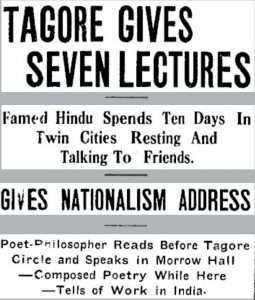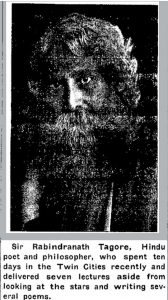On this date in 1861, just a few years ahead of the University of Illinois, Mr. Rabindranath Tagore was born. Although Mr. Tagore’s life is well-known, his time and his son’s studies at the University of Illinois might be less known. In fact, his writings would be continued to be read, discussed, and performed across campus and around town long after his first visit.
Read on to learn more about Rabindranath Tagore at the University of Illinois!
1916-1917
The year 1916 would continue the momentum of reading and remembering Sir Tagore and his writings. As early as February, Assistant Librarian F. K. W. Drury gave a talk highlighting the University library’s current collection of Sir Tagore’s publications.
- A 1916 Daily Illini article announcing Sir Tagore’s return in 1916, found in Record Series 41/8/801.
In early October of 1916, The Daily Illini reported, Sir Tagore would visit friends at the University for two days, following a scheduled tour talk in Chicago. When in Urbana, Sir Tagore would stay with the Seymours. In anticipation of his return, a Daily Illini editorial enthusiastically invited encouraged readers to “welcome him with traditional western hospitality”. As close as two days before his arrival, it was reported, that plans for a lecture were still unknown, while the possibility of a longer winter stay was rumored too. The following day, citing a tight speaking schedule including schools in Chicago, Iowa City, Iowa, and Appleton, Wisconsin, Sir Tagore’s October trip to Central Illinois was cancelled; but, Professor Seymour and others were committed to bring him back.
The Seymours and the Tagore Circle members advocated for Sir Tagore’s return to campus. Meanwhile, in October, the Seymours published the article “A Poet Out of the East” in Good Housekeeping (Volume 63, October 1916), which described the breadth of Sir Tagore’s work. That same month, in The Hindustanee Student, Professor Seymour published an article describing Sir Tagore’s visit to Japan (Volume III, Number 1). While in November, the Daily Illini reported that the Calcutta-based publication, The Modern Review, had published Mrs. Seymour’s poem “Hymn” (Volume 16, Issue 5).
By the end of November, it was also reported, the Tagore Circle was able to secure Sir Tagore’s visit to the University and a talk on January 13 at the Auditorium. Following a recent scheduling of Sir Tagore’s speaking tour, with plans to leave the U.S. by mid-January, the local talk was rescheduled for December 29 under the title “The Cult of Nationalism“. The tickets went on sale ten days in advance, on the 19th, with proceeds to be used for the Sankinetan school.
- A 1917 Daily Illini article reviewing Mr. Tagore’s recent visit, found in Record Series 41/8/801.
Ultimately, it was from December 22 through 31, 1916, when Sir Tagore returned to visit friends and give local talks, during his nation-wide tour. In fact, as The Daily Illini reported, Sir Tagore’s longest city visit was his ten-day stay in Urbana-Champaign. Some of his talks included, “Personality and Art” (Unitarian Church, Sunday, Dec. 24), “World Personality” (Tagore Circle, Monday), “The Second Birth” (Tagore Circle, Tuesday), “Sanyasi” (Tagore Circle, Wednesday), “Sankinetan” (Morrow Hall, Thursday), “Western Nationalism” (Friday), and “Nationalism in India” (Saturday).
- A 1917 Daily Illini article reviewing Mr. Tagore’s recent visit, found in Record Series 41/8/801.
Also during his trip, it was reported that Sir Tagore visited the Illinois observatory “…where for the first time he viewed the stars and the moon on a large telescope.” Aside from speaking, Sir Tagore continued to meet with students and continued writing too. Locals were particularly fortunate for the long visit by Sir Tagore, because not long later he became ill during the tour and he cancelled many of his later scheduled engagements. Sir Tagore’s second visit was well received, as remembered by Mrs. Seymour in an article published in The Hindustanee Student (Volume 3, Number 5) and The Modern Review (Volume 22, Number 1).
- A 1917 Daily Illini article announcing an event celebrating the anniversary of Mr. Tagore’s 1916, found in Record Series 41/8/801.
Local Readings and Early Tagore Family Visits
For years, Sir Tagore’s works continued to be discussed across campus. The student literary society known as the “Gregorian Society” organized a Tagore program in November 1917. For this celebration of the one year anniversary of Sir Tagore’s second visit, the Gregorian Society arranged a flute solo, a talk, poetry readings, and a vocal solo. The following year, during Chicago poet and Poetry magazine founder Harriet Monroe‘s 1918 guest lecture on “New Verse”, she included a discussion of Sir. Tagore’s writing and she even read his poem “The Gardner“. In fact, The Daily Illini reported, Poetry might have been the first English Language publication to publish Sir Tagore’s writings in English (“Poems“, Volume 1, 1912-1913, page 84-86). Meanwhile, off campus, in January 1918, Rev. Hail and Emily McClellan Vail published a book for religious instruction titled “Heroic Lives” which included biographies of great thinkers including Sir Tagore (Chapter XXII).
Months later, in national newspapers in March 1918, it was reported, Sir Tagore had been accused of plotting with the German government to support a revolution in India. Locally, in an interview with The Daily Illini, Dr. Seymour expressed his doubts of the connection and he defended Sir Tagore. The following day, a Daily Illini editorial essayed and reframed recent developments about the importance of Indian independence while emphasizing that the World War needed to be resolved first.
Meanwhile, local interest in Sir Tagore’s works continued. In February 1919, at the Natural History Hall, Dr. R.C. Whitford read a selection of contemporary free verse which included the 1916 publication “Fruit Gathering“. In April 1920, the Hindu Student Association organized a night of cultural talks including a performance of a scene from the play “Autumn Festival”. Later that year, citing an observation from a talk which Mr. Tagore gave at Princeton University, that Americans might not spend sufficient time alone, a DI writer quipped that Illinois members likely had as many committee meetings as our peers at Princeton. In December 1920, students organized a performance of “Chitra” at Morrow Hall.
- A 1921 Daily Illini article about Mr. Rathindranath Tagore’s campus visit, found in Record Series 41/8/801.
Even more connections grew. In February 1921, while Rathindranath and his father were visiting Chicago, he took the opportunity to visit his alma mater. Local students were enthusiastic to get Mr. Tagore to return to campus for a third visit, it was reported. Two months later, in April 1921, students organized a new campus performance of “Chitra“. While in November, for academic year 1922-1923, Political Science Professor James W. Garner (Record Series 15/18/20) had become the first American elected to the Tagore Professorship of Law at the University of Calcutta. In May 1922, for a mother’s day event, student performers sung a variety of songs including “The Cloud of Autumn”. In December, the Tagore Circle would meet at the home of Dr. Jacob Kunz. In January 1923, at an Urbana Woman’s Literary Club meeting, one member chose to discuss Tagore’s poetry at length. In April, the Thirty Club also discussed Tagore’s poetry, at the home of the Garners who returned from India. In December, at a Hindustan Student Club meeting, Mr. Surya Kanta Roy, (B.S. Agriculture, 1914), read selections of Tagore’s poetry. In February 1924, the Thirty Club organized a reading and discussion of “The Post Office“. In April, the Women’s Cosmopolitan Club presented “The Autumn Festival” which was followed by a selection of songs set to music.
- A 1927 Daily Illini article announcing Sushama Tagore’s campus visit, found in Record Series 41/8/801.
In fact, just a few years later, another member of the Tagore family visited Illinois. For a few days at the end of September 1927, during a national tour and while staying as a guest at the Kunz family home, Miss Sushama Tagore visited campus. During her campus lecture, as summarized in The Daily Illini, Miss Tagore emphasized that the uplift of women in India had to come from education system for them.
For the next decade, Mr. Tagore would continue to be read and discussed. In January 1929, the American Association of University Women meeting titled “An Afternoon in India” included Mrs. Morgan Brooks reading “An Unfinished Poem”. In October 1930, English Professor Paul Landis (Record Series 15/7/47) read a selection of Mr. Tagore’s poetry alongside student musical performers for a YWCA event. In December of that year, the Kappa Alpha Theta house organized their own literary discussion of his poetry. While in 1935, Mr. Tarini Prasad Sinha was invited to campus for two talks including “Gandhi and Tagore” for the Wesley League and “300,000,000 People Strive for Freedom” for the YMCA.
Many more readings and talks about Mr. Tagore would continue up to the present day. The 1956 India Night, featured students singing his poetry set to music. In 1961, as part of a celebration of Mr. Tagore’s centennial, in the Illini Union’s Wedgewood Lounge, there was an exhibit about Mr. Tagore’s works. The other half of the celebration featured two student performances, including “Chitra” in English and “Valmiki Pratibha” (“The Genius of Valmiki”) in Bengali. Finally, as recently as 1989, campus and community members organized the first Annual Tagore Festival in the very same chapel that hosted Tagore’s first lectures.
References
[] As always, a special thank you to all students and staff whose tireless work for student life and publications (many of which are available at the University Archives) help preserve the memories of Illini everywhere.
[] A comprehensive guide to the University Library’s holdings pertaining to Rabindranath Tagore can be found along with many other helpful LibGuides.
[] For personal remarks about Rabindranath Tagore’s experiences in the U.S., the University of Illinois, and Urbana-Champaign, can be read in publications like: Selected Letters Of Rabindranath Tagore. Edited by Krishna Dutta and Andrew Robinson. Cambridge: Cambridge University Press, 1997. For a bibliographic survey of his U.S. experiences documented in U.S. archives, please see: “Finding Rabindranath Tagore in the Holdings of the National Archives“, by Tisha Mondal and Judy Luis-Watson, in Education Updates. National Archives and Records Administration. Online.
[] For even further reading, please see: “Rabindranath Tagore in Urbana”, by Harold Hurwitz, in Indian Literature. 1961; “Tagore and the Urbana Unitarians 1906-1921”, by Ingrid Kallick, in Rabindranath Tagore for the 21st Century. Urbana: Tagore Center. 1992.; and “Cosmopolitan Club, Tagores, and UIUC: A Brief History of 100 Years” by Anil K. Bera. Self published. 2006.







